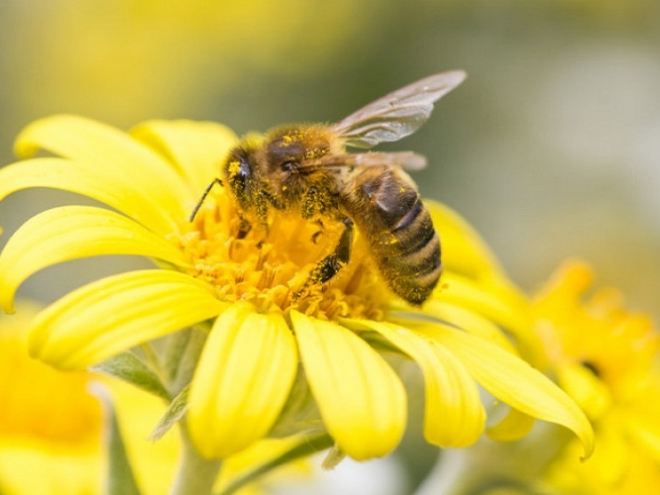Behavioral Neuroscience, lecture on Acetylcholine
Honey Bee Conditioned Drinking
VII. Octopamine (OA, Oct)
A. precursor = Tyrosine (Tyr, Y, 4-hydroxyphenylalanine)
1. synthetic enzyme: tyrosine decarboxylase = amino acid decarboxylase
2. tyramine
a. catecholamine releasing agent
b. cannot cross the blood brain barrier
c. Tyramine and dopamine (DA) have similar chemical structure
3. synthetic enzyme 2: tyramine b-hydroxylase = Dopamine b-hydroxylase = DbH
4. Octopamine (OA, Oct) a monoamine
a. Tyrosine à Tyramine à OA
5. Norepinephrine (NE) and OA have similar chemical structure
a. NE and OA have functional homology
B. Receptors (OA-R)
1. 7-transmembrane receptor
a. Closely related to norepinephrine (noradrenergic) receptors
b. All adrenergic and octopaminergic receptors are G-protein coupled
2. Octopamine1 – OAR1 = OctaR
à DG à PKC
a. activates GP/q/ll à PLC à PIP2 à IP3 à Ca++ à CamK
i. similar to NE a1 adrenergic receptors
b. honey bee (Apis mellifera) octopamine receptor: AmOCT1
i. Similar to DmOAMB
1) Drosophila melanogaster = Dm
2) mushroom body octopamine receptor DmOAMB
3. Octopamine2 – OAR2 = OctbR
a. activates Gs à AC à cAMP à PKA à CREB
i. similar to NE b1/2 adrenergic receptors
b. OAR2A receptor is presynaptic
i. inhibitory? Gi?
ii. OARs are known to inhibit cAMP (Gi)
iii. OARs also inhibit by opening Cl- channels
c. OAR2B receptor is postsynaptic
d. Octb3R
4. Class 3 - OAR3 = Tyr-R = OAR2C
a. binds both OA and Tyr
i. 53 kDa
b. Dominant in the CNS of insects
c. OAR3 glycoprotein (locust)
5. OARs cluster
a. Cluster type 1
i. with NE a2-adrenergic receptors
ii. plus DA D2, D3 and D4 receptors
b. Cluster type 2
i. wth b-adrenergic receptors
ii. and a1-adrenergic receptors
iii. plus DA D1 receptors
6. OA-Rs are restricted to invertebrates
a. a target for insecticides
C. catabolism via these enzymes
1. N-acetyl transferase
2. phenylethanolamine - N - methyltransferase (PNMT)
3. monoamine oxidase (MAO)
D. Reuptake
1. Octopamine transporter (OAT)
a. similar to DAT and NET
b. Primary mechanism to terminate neurotransmission
E. Invertebrate OA à OAR functions
1. Honey Bee
a. OA released from VUM-mx1
i. ventral unpaired medial neuron #1 of the maxillary neuromere
ii. Simulated by sucrose application to the proboscis/antennae
iii. Projects bilaterally to AL, MB calyces, and LH
b. involved in specific behavioral phenotypes
i. foragers
1) High OA in forager AL
2) Low OA in nurse AL
ii. Colony OA treatment à earlier onset of foraging behaviors
iii. [OA] do not change with greater foraging experience
iv. [OA] associated with foraging preference
1) nectar > water
c. Involved in learning and memory storage
i. appetitive learning
ii. reinforcement
1) DA for motor response
2. Octopus
a. OA discovered in 1948 from salivary glands
b. neurohormone, neuromodulator, neurotransmitter
c. physiological role is restricted to invertebrates
i. tyramine and OA
3. Lobster Homarus americanus
a. 86 OA-containing neurons
i. 4 classes of neurons
1) Neurosecretory anterior and posterior crotch cells
a) source of OA in hemolymph
2) Descending interneurons
3) Thoracic ascending interneurons
4) Brain ganglion neurons
b. behavior
i. CNS OA and 5-HT responsible for social status
1) OA à subordinate
2) 5-HT à dominant
ii. increase response of postural muscles to central motor output
c. Stomatogastric ganglion OA controls pyloric and gastric mill rhythms
d. Abdominal Stretch receptor organ
i. Modulated by prolactin, 5-HT, and OA
1) Excitatory and inhibitory
4. Crayfish
a. inhibits Swimmeret rhythm
5. Leech - released from Leydig cells
6. Other Insects
a. OA released from DUM-neurons in times of stress
i. coping with high energy demand
1) long term flight
b. Firefly - leads to glowing of the abdomen
i. DUM-neurons of distal 2 abdominal ganglia
c. Cockroach - direction sensitivity of auditory system
7. Vertebrate OA
a. chronic MOA inhibitors: OA replaces NE in sympathetic neurons
8. Hemolymph (hormonal) actions
a. Heart
i. Increasing intracellular cAMP
ii. lobster, crab, locust, and hawkmoth
b. OA activated lobster wound response
i. non-self (immune) hemolymph clean-up
ii. cockroach: 5-HT and OA elevate hemocyte phagocytosis
c. Lobster Behavior
i. OA enhances pheromone responses
1) 20 to 80% in males
ii. Inject OA
1) Subordinate behavior
2) Crouch low with claws and abdomen stretched out
iii. Inject 5-HT
1) Dominant posture
2) Sustained flexion of limbs and abdomen
